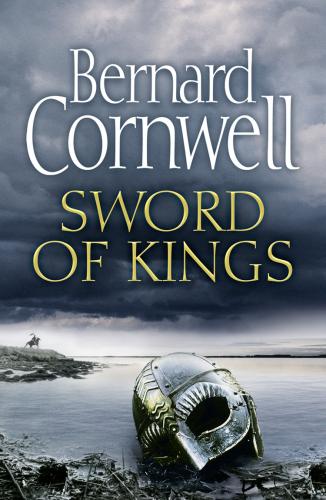SWORD OF KINGS
Bernard Cornwell
HarperCollinsPublishers Ltd
1 London Bridge Street
London SE1 9GF
First published in Great Britain by HarperCollinsPublishers 2019
Copyright © Bernard Cornwell 2019
Map © John Gilkes 2019
Cover design by Holly Macdonald © HarperCollinsPublishers Ltd 2019
Cover photograph © CollaborationJS/Arcangel Images (helmet/foreground and horse detail in background) and Shutterstock.com (all other images)
Bernard Cornwell asserts the moral right to be identified as the author of this work.
A catalogue copy of this book is available from the British Library.
This novel is entirely a work of fiction. The names, characters and incidents portrayed in it are the work of the author’s imagination. Any resemblance to actual persons, living or dead, events or localities is entirely coincidental.
All rights reserved under International and Pan-American Copyright Conventions. By payment of the required fees, you have been granted the non-exclusive, non-transferable right to access and read the text of this e-book on screen. No part of this text may be reproduced, transmitted, down-loaded, decompiled, reverse engineered, or stored in or introduced into any information storage and retrieval system, in any form or by any means, whether electronic or mechanical, now known or hereinafter invented, without the express written permission of HarperCollins.
Source ISBN: 9780008183899
Ebook Edition © OCTOBER 2019 ISBN: 9780008183912
Version: 2019-08-29
Sword of Kings is for
Suzanne Pollak
Contents
Copyright
Dedication
Place Names
Map
Part One: A Fool’s Errand
One
Two
Three
Four
Part Two: City of Darkness
Five
Six
Seven
Part Three: The Field of Barley
Eight
Nine
Ten
Part Four: Serpent-Breath
Eleven
Twelve
Thirteen
Historical Note
About the Author
Also by Bernard Cornwell
The Sharpe series
About the Publisher
The spelling of place names in Anglo-Saxon England was an uncertain business, with no consistency and no agreement even about the name itself. Thus London was variously rendered as Lundonia, Lundenberg, Lundenne, Lundene, Lundenwic, Lundenceaster and Lundres. Doubtless some readers will prefer other versions of the names listed below, but I have usually employed whichever spelling is cited in either the Oxford Dictionary of English Place-Names or the Cambridge Dictionary of English Place-Names for the years nearest or contained within Alfred’s reign, AD 871–899, but even that solution is not foolproof. Hayling Island, in 956, was written as both Heilincigae and Hæglingaiggæ. Nor have I been consistent myself; I have preferred the modern form Northumbria to Norðhymbralond to avoid the suggestion that the boundaries of the ancient kingdom coincide with those of the modern county. So this list of places mentioned in the book is, like the spellings themselves, capricious.
| Andefera | Andover, Wiltshire |
| Basengas | Basing, Hampshire |
| Bebbanburg | Bamburgh, Northumberland |
| Beamfleot | Benfleet, Essex |
| Caninga | Canvey Island, Essex |
| Ceaster | Chester, Cheshire |
| Celmeresburh | Chelmsford, Essex |
| Cent | Kent |
| Cestrehunt | Cheshunt, Hertfordshire |
| Cippanhamm | Chippenham, Wiltshire |
| Colneceaster | Colchester, Essex |
| Contwaraburg | Canterbury, Kent |
| Cyningestun | Kingston upon Thames, Surrey |
| Crepelgate | Cripplegate, London |
| Dumnoc | Dunwich, Suffolk |
| East Seax | Essex |
| Elentone | Maidenhead, Berkshire |
| Eoferwic | Saxon name for York, Yorkshire |
| Fæfresham | Faversham, Kent |
| Farnea Islands | Farne Islands, Northumberland |
| Fearnhamme | Farnham, Surrey |
| Ferentone | Farndon, Cheshire |
| Fleot, River |
River Fleet, London
|
